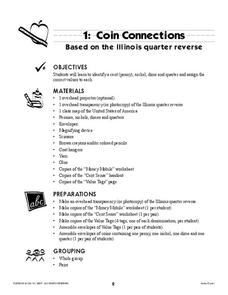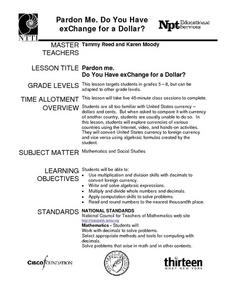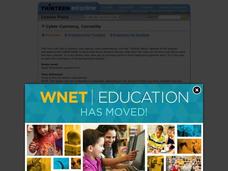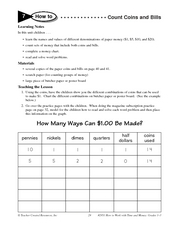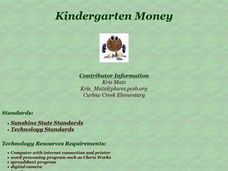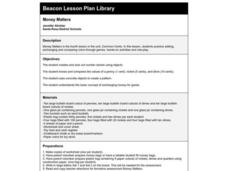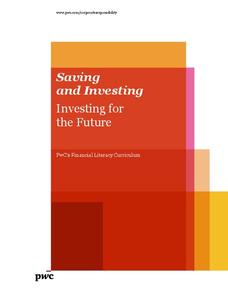Curated OER
Time Value of Money
Students evaluate the time value of money. In this economics lesson, students define inflation, interest, and the future value of money.
Curated OER
Show Me The Money
Third graders explore the value of U.S. money. In this money lesson, 3rd graders print out pictures of money from the Internet and create play money. The students will play a game in which they display the amount of money called out by...
Curated OER
Place Value of Decimals to Hundredths: Diving for Decimals
Constructing decimals correctly is a crucial concept for elementary students to grasp. Here, have the young mathematicians in your class explore standard and expanded form while comparing decimal values. This unit is taught while...
Curated OER
Coin Connections
A wonderful lesson on identifying the penny, nickel, dime, and quarter awaits your young mathematicians. They engage in a multi-session lesson which allows them to practice using the values of each coin in worksheets and activities...
Curated OER
Pardon Me. Do You Have Change For a Dollar?
Upper elementary and middle school learners explore currencies from a variety of countries. They use the Internet, video, and engage in hands-on activities. They practice converting U.S. currency to foreign currency and vice versa. This...
Curated OER
Cyber Currency, Currently
Students explore the value of currency and how to save and earn interest. In a key lesson, kids even get to purchase items in their classroom's general store. It's a fun way to learn the importance of being financially literate!
Curated OER
My Money
Students identify and interpret the relationships between various components of currency, discusses the uses of money, and provides advanced lessons on making change. They also identify the various ways that money is used and how to use...
Curated OER
Whole Number and Decimal Place Value
Practice real-world application of decimals by viewing the U.S. National Debt Clock online and discussing the level of outstanding debt. A skit, vocabulary, and various other resources are available.
Curated OER
We're in the Money
Students study money and its place in the economy. In this middle school Consumer Math lesson, students explore the barter system and the need for money. Students explore how money works in society and explore modern money...
Curated OER
How To: Count Coins and Bills
Students discover the names and values of different monetary denominations. In this money lesson, students examine the different combinations that money can be added in to find specified amounts. The students complete worksheets based on...
Curated OER
It's in Your Pocket
Students examine American coins. In this American currency lesson, students study how American money came to be as well as the responsibilities of the U.S. Mint. Students discover details regarding American coins and design their own coins.
Curated OER
Undercurrents Of Currency
Students investigate the currencies used by different countries, and explore the principles of currency trading by exchanging currencies at current market rates. They, in groups, access websites which give them current rates.
Curated OER
Kindergarten Money
Students identify the various coins and their values through presentations, a rubric, a value pretest, and coin manipulatives. Money is incorporated into various activities whether at home or in school. Students create money webs using...
Curated OER
A Lesson to Accompany "Benjamin Franklin and the Birth of a Paper Money Economy"
Students examine the role of money in the colonial economy by participating in a trading activity. In this colonial economy lesson, students complete an activity to learn about colonial trade and what happens when there is a lack of...
Curated OER
Money Matters
Students play a game called Money Matters using cut out representatives of pennies, nickels, and dimes.
PwC Financial Literacy
Saving and Investing: Investing for the Future
A fine lesson on saving and investing is here for you and your middle schoolers. In it, learners explore the values of time and money, and discover how small amounts of money invested over time can grow into a large "pot of gold." They...
Curated OER
Lesson 3: Where Does Money Come From?
Students listen to story Hundred Penny Box by Sharon Bell Mathis, explore history of money, and examine how money is produced in the United States. They discuss why money is used for exchange, and describe how money has changed over time.
Curated OER
How Many? How Much?
First graders recognize and learn the value of coins. For this instructional activity on money, 1st graders read the book Monster Money by Grace Maccarone, discuss the role of money in society, identify various coins, and explore making...
Curated OER
Money Booklet
Students practice handling money by examining different world currency. In this economics lesson, students utilize a coin booklet to trace individual coins and draw bills, later coloring them in their traditional colors....
Curated OER
Currency and Exchange Rates
Fifth graders share the book, "The Story of Money" and discuss the uses of money, bartering, trade and the history of money. Students discuss various ways of spending: cash, check, debit/credit cards and review the check writing process....
Curated OER
Money and Business (Art)
Third graders investigate world currency by creating their own coin art. For this government lesson, 3rd graders examine the characteristics of different coins and create their own design for a new one. Students discuss and...
Curated OER
Introducing money (Elementary, Mathematics)
Students study the penny, nickel, dime and quarter, one each day for four days, using a magnifying glass to identify the similarities. Then students discuss differences and value and learn a 'rap' to memorize values.
Curated OER
Understanding the Effects of Currency Exchangerates
Students examine the economic effects of a strong and weak U.S. dollar. They identify the currency used in countries which regularly trade with the U.S., discuss the pros and cons of a strong U.S. dollar, and calculate the prices in...
Curated OER
Math -- Money
Students identify a penny, nickel, dime, quarter and a half dollar. They examine the value of each coin and its equivalents (to quarter/dollar). After pairing up with a classmate, each one drills the other one on each coin.



